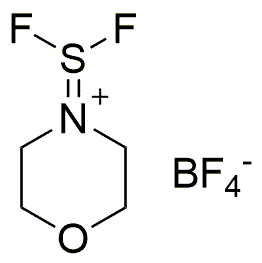Difluoro(morpholino)sulfonium tetrafluoroborate is widely utilized in research focused on:
- Organic Synthesis: This compound serves as a powerful reagent in organic chemistry, facilitating the introduction of fluorine into various organic molecules, which can enhance their reactivity and stability.
- Pharmaceutical Development: It plays a crucial role in the synthesis of fluorinated pharmaceuticals, which often exhibit improved bioactivity and pharmacokinetic properties compared to their non-fluorinated counterparts.
- Material Science: The compound is used in developing advanced materials, particularly in the production of polymers with enhanced thermal and chemical resistance, making them suitable for demanding applications.
- Electrochemistry: It is employed in electrochemical studies, particularly in the development of new battery technologies, where its unique properties can improve energy storage and efficiency.
- Analytical Chemistry: This chemical is utilized in various analytical techniques, aiding in the detection and quantification of other compounds, which is essential for quality control in manufacturing processes.
General Information
Properties
Safety and Regulations
Applications
Difluoro(morpholino)sulfonium tetrafluoroborate is widely utilized in research focused on:
- Organic Synthesis: This compound serves as a powerful reagent in organic chemistry, facilitating the introduction of fluorine into various organic molecules, which can enhance their reactivity and stability.
- Pharmaceutical Development: It plays a crucial role in the synthesis of fluorinated pharmaceuticals, which often exhibit improved bioactivity and pharmacokinetic properties compared to their non-fluorinated counterparts.
- Material Science: The compound is used in developing advanced materials, particularly in the production of polymers with enhanced thermal and chemical resistance, making them suitable for demanding applications.
- Electrochemistry: It is employed in electrochemical studies, particularly in the development of new battery technologies, where its unique properties can improve energy storage and efficiency.
- Analytical Chemistry: This chemical is utilized in various analytical techniques, aiding in the detection and quantification of other compounds, which is essential for quality control in manufacturing processes.
Documents
Safety Data Sheets (SDS)
The SDS provides comprehensive safety information on handling, storage, and disposal of the product.
Product Specification (PS)
The PS provides a comprehensive breakdown of the product’s properties, including chemical composition, physical state, purity, and storage requirements. It also details acceptable quality ranges and the product's intended applications.
Certificates of Analysis (COA)
Search for Certificates of Analysis (COA) by entering the products Lot Number. Lot and Batch Numbers can be found on a product’s label following the words ‘Lot’ or ‘Batch’.
Numéro de catalogue
Numéro de lot/série
Certificates Of Origin (COO)
This COO confirms the country where the product was manufactured, and also details the materials and components used in it and whether it is derived from natural, synthetic, or other specific sources. This certificate may be required for customs, trade, and regulatory compliance.
Numéro de catalogue
Numéro de lot/série
Safety Data Sheets (SDS)
The SDS provides comprehensive safety information on handling, storage, and disposal of the product.
DownloadProduct Specification (PS)
The PS provides a comprehensive breakdown of the product’s properties, including chemical composition, physical state, purity, and storage requirements. It also details acceptable quality ranges and the product's intended applications.
DownloadCertificates of Analysis (COA)
Search for Certificates of Analysis (COA) by entering the products Lot Number. Lot and Batch Numbers can be found on a product’s label following the words ‘Lot’ or ‘Batch’.
Numéro de catalogue
Numéro de lot/série
Certificates Of Origin (COO)
This COO confirms the country where the product was manufactured, and also details the materials and components used in it and whether it is derived from natural, synthetic, or other specific sources. This certificate may be required for customs, trade, and regulatory compliance.


